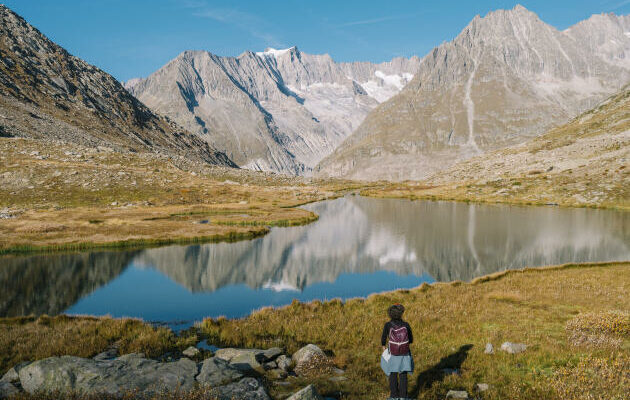Contemplating it from the peaks that surround it provides a certain emotion. But treading on ice provokes an intoxication of a completely different order. To get in touch with the Aletsch glacier – the largest in Europe – which is born under the highest mountains of the Swiss Valais and forms a tongue of ice 22 kilometers long, 81 kilometers in surface area and 11 billion tonnes, it’s quite a ceremony.
At the end of an approach walk under a bright autumn sun, at an altitude of 2,300 meters, you have to put your jacket and hat back on. Like a frozen river flowing from the peaks of Jungfrau and Mönch in the distance, it occupies the entire width of the narrow valley. The wind that rushes through this corridor quickly freezes you to your feet. You must then wear gloves to prevent injuries caused by sharp ice in the event of a fall. Put on crampons to grip the ground as slippery as an ice rink. Finally, tie up with your companions, because stepping sideways is not desirable.
If, seen from above, the giant of Aletsch seems as flat as placid, its relief reveals itself, in reality, tormented, from hollows to bumps, from fine plunging edges to flat areas, from folds to projections. Crevasses invisible to lay eyes shear its 300 meters of thickness at this location. It is with measured steps that the rope travels in this new world. “It’s another planet”, says Alexandra Peclat, 57, who is one of them. She, who so often follows her paragliding husband on these Valais slopes, is moved to tears to evolve for the first time in this extraordinary natural space that she has admired dozens of times from afar.
Everywhere, it crunches and cracks. The silence is filled with the dull, rolling sound of water flowing somewhere beneath the crampons. This soundtrack is not unrelated to the emotion that grips the explorers of a day. Because, like all glaciers in the Alps, the Aletsch glacier is melting under the effect of global warming. The Swiss giant was formed twenty-four thousand years ago when the entire Rhône valley and the side valleys of Valais were covered by an immense ice cap from which only the highest peaks emerged, like arrowheads, the 4,000 meters that make this region famous.
For millennia, a meter of fresh snow falling from above, frozen then thawed several times, forms, by accumulation, in the space of ten years, a centimeter of ice, which, under the effect of gravity, puts the glacier moving downstream, like honey on toast, at a speed of 200 meters per year. This perpetual movement carries summit stones downward, forming moraines, these long stripes which stand out in the icy white and shape this grandiose landscape. The colossus once did so well that it threatened meadows and pastures. At the end of the 17th centurye century, the inhabitants of Fiesch, in the valley, pronounced, with Pope Innocent “ban the glacier” and to pray to stop its advancement.
You have 65% of this article left to read. The rest is reserved for subscribers.
